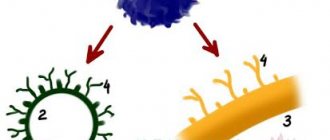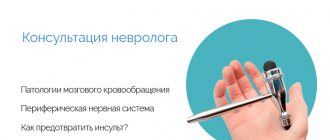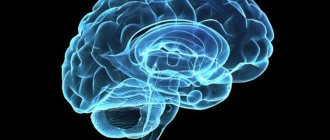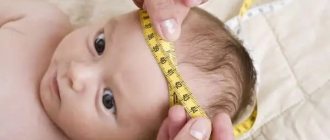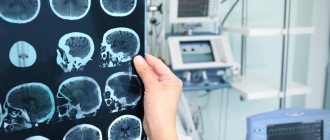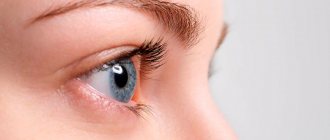Treatment should always seek the causes of the disease through logic, understanding and “respect” of structures - Leopold Busquet.
In recent years, the number of children with attention and memory deficiencies, increased distractibility and mental fatigue, and speech defects has increased sharply. Many of these children exhibit disorders of social adaptation, impaired writing and reading, various dysfunctions of the gastrointestinal tract, and postural defects. This is evidenced by the work practice of child neurologists, educators and teachers of preschool institutions and primary schools.
The existing medical examination system for children under one year of age provides for examinations by a pediatric neurologist after 3 months, which makes it possible to identify disturbances in the child’s development and carry out appropriate corrective measures.
In the future, greater responsibility falls on the parents. If you notice any abnormalities in your child’s motor, mental, or speech development, do not wait until “everything goes away on its own,” contact the doctors at our medical center, who specialize in restoring your child’s adaptive mechanisms.
When a neurologist tells parents at an appointment: “Your child has perinatal damage to the central nervous system,” the question immediately arises: “What is this connected with and what threatens the child in later life? What do we do now?"
Perinatal lesions of the central nervous system are a collective diagnosis that implies a dysfunction of the brain or the structure of the brain itself of various origins, occurring during pregnancy, childbirth and the first week of a child’s life.
According to their origin and course, all brain lesions of the perinatal period can be divided into:
- hypoxic-ischemic, occurring as a result of a lack of oxygen supply to the fetus during pregnancy (chronic intrauterine fetal hypoxia) or childbirth (acute fetal hypoxia or asphyxia);
- traumatic, most often caused by traumatic damage to the fetal head at the time of birth;
- mixed: hypoxic-traumatic lesions of the central nervous system
What are the features in the development of the nervous system of children?
At the time of birth, the baby's brain weight is one tenth of his body weight.
By nine months, the brain mass doubles. By the age of three it triples. The mass of the adult human brain is 1/40 of the body mass. It turns out that per kilogram of a newborn’s body weight there is approximately 109 grams of brain matter, and in an adult it is only 20-25 grams. During the prenatal period, the parts of the brain are formed from five brain vesicles. But by the time a child is born, brain formation is not yet complete. There are certain age-related features of the anatomy of the central nervous system:
- The convolutions of the cerebral hemispheres and the large grooves between these convolutions are small in height and also in depth. The number of small grooves is small. But their number increases in the first months of life;
- The frontal lobe is small and the occipital lobe is large compared to the same parts of the adult brain;
- Poor development of the cerebellum. Its hemispheres are small, the bark is thin, the furrows are superficial;
- Relatively large volume of the lateral ventricles of the brain.
At the very beginning of life, the gray matter of the baby’s brain is still poorly demarcated from the white matter. Complete differentiation of the cortex ends by school age. Only by the age of eight years does the cerebral cortex of a little person become similar in macro- and microscopic structure to the adult cortex.
Phylogenetically, early structures are better formed at the time of birth. The nuclei of the hypothalamus, medulla oblongata and spinal cord in the anatomical and functional state are more mature than the cerebral cortex, pyramidal tracts and striatum. Due to these factors, at the time of birth, life-sustaining activity is regulated at the subcortical level.
Children under one year old retain some reflexes, which, as they grow older, lose their significance and are reduced. For example, the hand-mouth reflex provides nutritional needs in the first months of life. And the automatic walking reflex, which manifests itself even in the prenatal period of development, prepares the baby for future upright walking. Subsequently, conditioned reflexes are formed, which will help the child adapt to a new environment and evaluate changing environmental conditions.
During early childhood, stable conditional connections of the emerging personality with society are formed. Children learn extremely quickly.
Over the years, the rate of formation of cognitive skills decreases exponentially. And those skills and behavior patterns that were acquired before the age of three remain for life.
Before the beginning of the second month of life, the baby develops several elementary conditioned reflexes. And by the end of the third month, it becomes possible to form complex, differentiated reflexes. This indicates the rapid development of the analyzing function of the cerebral cortex.
A newborn cannot yet differentiate signals coming from different sense organs. During this period, the child perceives the world in a generalized way. And only after two months of age does he begin to highlight certain aspects of his environment (mother, toys, food).
With the growth and development of a little person, many millions of nerve cells - neurons - die. At the same time, the formation of interneuron connections occurs. Memory develops with this process.
The younger the child, the faster the development of the nervous system occurs. The most intensive period of development is the first three months of a baby’s life.
The blood supply to the brain in children is better, thanks to which the organ is provided with an abundant supply of oxygen and glucose. But in children of the first year of life, venous outflow through diploic veins (as in adults) is difficult. These veins are finally formed only when the fontanelles close. In addition, the blood-brain barrier is fully formed by the age of three. Therefore, the brain of children at this age is especially susceptible to intoxicating factors (neurotoxicosis).
From the age of two, the child’s brain is already mature enough to form the second signal system - speech. The main contribution to the development of linguistic skills comes from the child’s communication with adults: parents, relatives, and educators.
Increased intracranial pressure: symptoms
Hypertensive-hydrocephalic syndrome is an excessive accumulation of cerebrospinal fluid in the ventricles and under the meninges. To identify this syndrome in an infant, an ultrasound scan of the brain is performed and data on increased intracranial pressure are recorded (according to echoencephalography - EEG).
In pronounced severe cases of this syndrome, the size of the brain part of the skull increases disproportionately. As is known, children are born with mobile bones of the skull, which fuse during development, therefore, with a unilateral pathological process of this syndrome, divergence of cranial sutures, thinning of the skin in the temporal lobe and increased venous pattern on the scalp will be observed.
If a child has increased intracranial pressure, he will be restless, irritable, easily excitable and whiny. Also, the baby will sleep poorly, roll his eyes and throw his head back. Graefe's symptom (a white stripe between the pupil and the upper eyelid) may occur. In more severe cases, there may also be a symptom of the so-called “setting sun”, in which the iris of the eye, like the sun at sunset, is half submerged under the lower eyelid. Convergent strabismus also sometimes appears.
With reduced intracranial pressure, on the contrary, the child will be inactive, lethargic and drowsy. Muscle tone in this case is unpredictable - it can be either increased or decreased. The baby may stand on tiptoes when supported, or cross his legs when trying to walk, while the baby’s support, crawling and walking reflexes will be reduced. Seizures can also often occur.
How a child's personality is formed
The formation of personality is a complex and multi-stage process in which complex connections of a person as an individual with the objective world are naturally formed. As we have already said, according to Locke’s theory of tabula rasa, our psyche (from psychos - soul) is a “blank slate”. And in the process of life, everything that a person encounters leaves its imprint on this board. In childhood, these traces are most vivid.
In order for a child to develop properly, he needs a clear daily routine - a regime. The baby is specially and arbitrarily taught good and bad skills. Parents must create comfortable conditions so that speech, targeted motor activity, and proper physical and mental development can be formed.
There are several approaches to describing the stages of personality development. Not all of them are clear and unambiguous.
For example, according to Freud’s theory of mental development of children, a child goes through several stages in his development:
- oral;
- anal;
- phallic;
- latent;
- genital
But as some of the most suitable, we can highlight the stages of “birth of personality” according to Leontiev:
- The first “birth” of personality is in preschool age. At this time, the child first correlates personal motives and needs with social rules. And submits to these social demands;
- During adolescence, the second “birth” of the personality occurs. It is directly related to the quality of education. What was invested in the child over the previous years of development is born in the form of his almost formed personality. The little man is aware of his motives and can prefer or subordinate them. Self-leadership and self-awareness emerge. Because of this, the child begins to bear criminal responsibility and be responsible for certain offenses according to the law.
From the point of view of this theory of mental development, the child’s personality experiences two crisis moments: the first in preschool age and the second in adolescence. However, the concept of this theory does not describe mental development in infancy. And this is also important for a holistic understanding of everything that can happen to a growing organism. Because the foundations for personality formation are laid when the baby doesn’t even know how to walk.
Theories of mental development describe ideal sequential stages through which a child should pass in due course.
Aspects that are necessary for the successful formation of a healthy personality:
- Confidence. This is the first personal quality that should be taught to a child. The child must learn to distinguish between those situations in which he can trust unconditionally, and those in which he should be more attentive to the words and actions of others.
- Safety. During infancy, children should not be exposed to extreme situations. The only thing that is required for them in this period of life is to be in a calm and safe environment with loving parents.
- Initiative. You need to praise your child for good deeds, encouraging him to always do the right thing. Often parents forget to do this (although they always practice punishment).
How to assess a child’s neuropsychological development
The individuality of each baby is undeniable. But the pace of development is different for all children. A child may acquire certain skills earlier than normal, while others later. Be that as it may, the growth and maturation of the individual must be adequate to the age, gender, and psychological characteristics of the little person. At the same time, the harmonious development of the neuropsychic sphere also plays an important role.
Developmental delay forces parents to think about possible causes. Some skills may be ahead of age standards, while others may not reach the standards. But if the baby is lagging behind in several respects, parents should think about whether they are doing everything right in raising the heir.
Conditioned reflex activity of children, development of emotions and forms of communication
Conditioned reflex activity begins to form immediately after birth. The crying baby is picked up, and he becomes silent and makes exploring movements with his head, anticipating feeding. At first, reflexes form slowly and with difficulty. With age, the concentration of excitation develops, or the irradiation of reflexes begins. As the child grows and develops, from about the 2nd-3rd week, differentiation of conditioned reflexes occurs. In a 2-3 month old child, a fairly pronounced differentiation of conditioned reflex activity is observed. And by 6 months, children can develop reflexes from all sensory organs. During the second year of life, the child’s mechanisms for the formation of conditioned reflexes are further improved.
At 2-3 weeks, while sucking, after taking a break to rest, the baby carefully examines the mother’s face and feels the breast or bottle from which he is fed. By the end of the 1st month of life, the child’s interest in the mother increases even more and manifests itself outside of meals. At 6 weeks, the mother's approach makes the baby smile. From the 9th to the 12th week of life, hearing is formed, which is clearly manifested when the child communicates with his mother. General motor excitement is observed.
By 4-5 months, the approach of a stranger causes the noise to stop, and the child carefully examines him. Then either general excitement appears in the form of joyful emotions, or as a result of negative emotions - crying. At 5 months, the child already recognizes his mother among strangers and reacts differently to the disappearance or appearance of his mother. By 6-7 months, children begin to develop active cognitive activity. While awake, the child manipulates toys; often a negative reaction to a stranger is suppressed by the manifestation of a new toy. Sensory speech is formed, i.e. understanding the words spoken by adults. After 9 months there is a whole range of emotions. Contact with strangers usually causes a negative reaction, but it quickly becomes differentiated. The child develops timidity and shyness. But contact with others is established thanks to interest in new people, objects, and manipulations. After 9 months, the child’s sensory speech develops even more; it is already used to organize his activities. The formation of motor speech also dates back to this time, i.e. pronouncing individual words.
Symptoms of disorders
We list the symptoms that parents and educators should pay attention to in order to promptly identify disorders in mental development:
- Speech disorders: the child does not speak, spoken words and phrases have no connection with each other and do not correspond to the situation, diction disorders after 5 years of age;
- Communication disorders: relationships in the children's team do not work out (in kindergarten, on the playground in the yard with other children), the child is withdrawn, aggressive, “unsociable,” or, on the contrary, is too intrusive in communication, without feeling the limits.
- Lack of interest in toys and games: if a child avoids toys, uses them for other purposes.
If you suspect disorders of normal mental development in a child, you should contact a child psychologist, neuropsychologist, neurologist or psychiatrist (child psychiatrist).
Speech development
The formation of speech is a stage in the formation of human personality. Special brain structures are responsible for a person’s ability to articulate. But speech development occurs only when the child communicates with another person, for example, with his mother.
There are several stages in the development of speech.
Preparatory stage . The development of humming and babbling begins at 2-4 months.
The stage of the emergence of sensory speech . This concept means the child’s ability to compare and associate a word with a specific object or image. At 7-8 months, the child, in response to the questions: “Where is mom?”, “Where is the kitty?”, begins to look for an object with his eyes and fix his gaze on it. Intonations that have a certain coloring can be enriched: pleasure, displeasure, joy, fear. By the age of one year, a child already has a vocabulary of 10-12 words. The child knows the names of many objects, knows the word “no”, and fulfills a number of requests.
Stage of emergence of motor speech . The child speaks his first words at 10-11 months. The first words are built from simple syllables (ma-ma, pa-pa, dyad-dya). A child's language is formed: a dog - “aw-aw”, a cat - “kitty-kitty”, etc. In the second year of life, the child’s vocabulary expands to 30-40 words. By the end of the second year, the child begins to speak in sentences. By the age of three, the concept of “I” appears in speech. More often than not, girls master motor speech earlier than boys.
In children from the newborn period, a mechanism of instant contact - imprinting - is formed. This mechanism, in turn, is associated with the formation of the child’s neuropsychic development.
Maternal upbringing very quickly creates a sense of security in a child, and breastfeeding creates a feeling of security, comfort, and warmth. The mother is an indispensable person for the child: she forms his ideas about the world around him, about the relationship between people. In turn, communication with peers (when the child begins to walk) forms the concept of social relationships, camaraderie, and inhibits or enhances the feeling of aggressiveness. The father also plays a large role in raising a child. His participation is necessary for the normal building of relationships with peers and adults, the formation of independence and responsibility for a particular matter, and a course of action.
What are the types of PPCNS syndromes?
PPCNSL is conventionally divided into several periods, depending on at what stage the disorder was identified and how it manifested itself.
– The acute period lasts from 7 to 10 days, it is extremely rare, but it can last up to a month.
– The period during which recovery occurs (recovery period) can last up to 6 months. If the child’s body recovers slowly, this period may take up to 2 years.
Pediatric neurologists distinguish the following types of perinatal lesions of the central nervous system, depending on the accompanying symptoms and syndrome:
– Violation of muscle tone . This syndrome is diagnosed according to deviations from the norm depending on the age of the infant. In the initial period of a child’s life, it is quite difficult to diagnose this syndrome, since in addition there is physiological hypertonicity (physiological stiffness of the newborn’s muscles).
– Nervous-reflex excitability syndrome is a syndrome associated with sleep disturbances, trembling of the chin, and the child flinching at any rustle or touch. This syndrome can be diagnosed only when somatic diseases of the newborn (for example, intestinal colic) are excluded. When examining such a child, the neurologist determines an increase in tendon reflexes, as well as an increase (revitalization) of the newborn’s automatisms (Moro reflex).
– Nervous system depression syndrome . This syndrome is the opposite in its characteristics to the previous one. It is diagnosed in children who are not active in the first months of their lives, they sleep a lot, they have decreased tone, they cannot hold their head up, and they have difficulty grasping their hands.
– An unfavorable prognosis for the child if intracranial hypertension syndrome . Its main signs are increased excitability and nervousness, while the fontanel begins to swell and thicken. Frequent regurgitation appears. Upon examination, the neurologist notices excessive growth of head circumference, possible divergence of the sutures of the skull, Graefe’s symptom (the “setting sun” symptom).
– One of the most dangerous and severe conditions in PPCNS is convulsive syndrome , which is one of the most serious manifestations of perinatal damage to the central nervous system.
In addition, any attentive mother can notice deviations in her child’s health much faster than a neurologist, if only because she monitors him around the clock and more than one day.
In any case, a baby living for the first year with any (even minimal, but not passing) deviations in health requires repeated consultations with specialists at the medical center, inclusion in the medical examination program (i.e. close observation by a neurologist and, if necessary, additional examination , such as ultrasound of the brain, electroencephalography, blood testing to determine the compensatory potential of the nervous system, etc.). Based on the findings received, the center’s specialists develop a development plan for such a child, select an individual scheme for preventive vaccinations, introduce complementary foods into the diet, and carry out therapeutic measures if necessary.
What are the symptoms and diagnostic criteria for PCNSL?
– Not every mother who does not have a medical education will be able to distinguish and determine at first glance that her child has a perinatal lesion of the central nervous system. But neurologists accurately determine the disease by the appearance of symptoms that are not characteristic of other disorders.
– when examining the baby, muscle hypertonicity or hypotonicity may be detected;
– the child is excessively restless, anxious and excited;
– the occurrence of trembling in the chin and limbs (tremor);
– the appearance of seizures;
– when examined with a hammer, a violation of the reflex sphere is noticeable;
– the appearance of unstable stools;
– heart rate changes; the appearance of irregularities on the child’s skin.
As a rule, after a year these symptoms disappear, but then appear with renewed vigor, so this situation simply cannot be neglected. One of the most dangerous manifestations and consequences of PPCNSL in the absence of a response to symptoms is the suspension of the development of the child’s psyche. The speech apparatus does not develop, and there is a delay in the development of motor skills . Also, one of the manifestations of the disease may be cerebrasthenic syndrome.
Dream
For full development, a child needs proper sleep. In newborns, sleep is polyphasic. During the day, the child falls asleep from five to 11 times, not distinguishing day from night. By the end of the 1st month of life, the rhythm of sleep is established. Night sleep begins to prevail over daytime sleep. Hidden elements of polyphase persist even in adults. On average, the need for nighttime sleep decreases over the years.
A decrease in the total duration of sleep in children occurs due to daytime sleep. By the end of the first year of life, children fall asleep once or twice. By the age of 1-1.5 years, the duration of daytime sleep is 2.5 hours. After four years, not all children have daytime sleep, although it is advisable to maintain it until the age of six.
Sleep is organized cyclically, i.e. the slow-wave sleep phase ends with the REM sleep phase. Sleep cycles change several times during the night.
In infancy, sleep problems usually do not occur. At the age of one and a half years, the child begins to fall asleep more slowly, so he himself chooses techniques that promote falling asleep. It is necessary to create a familiar environment and behavior pattern before bedtime.
Treatment of a child with central nervous system damage
Accurate diagnosis and timely correct treatment of CNS pathology is extremely important. The child’s body is very susceptible to external influences at the initial stage of development, and timely procedures can radically change the future life of the child and his parents, allowing at the earliest stages to get rid of problems with relative ease that can become very significant at a later age.
As a rule, children with early age pathologies are prescribed drug therapy in combination with physical rehabilitation. Therapeutic exercise (physical therapy) is one of the most effective non-drug methods of rehabilitation of children with central nervous system lesions. A properly selected course of exercise therapy helps restore the child’s motor functions, using the adaptive and compensatory capabilities of the child’s body.
What are unconditioned reflexes?
The unconditioned reflexes of a newborn are, first of all, nature-programmed responses and protective reactions to external stimuli that are necessary for the child’s life. Without these reflexes, the child would not be able to find the nipple and take the breast, or carry out the correct sucking movements. Almost all unconditioned reflexes are formed by the time of birth and persist from 1.5 to 4–5 months of a child’s life, giving way to the development of conscious motor skills. Longer preservation of a newborn's reflexes prevents the formation of these skills and is a manifestation of pathology.
So what unconditioned reflexes are characteristic of a newborn? Let's list
- search reflex (when stroking the corner of the mouth, the child turns his head in this direction and tries to touch the stimulus with his tongue);
- sucking reflex (when any object enters the child’s mouth, the baby grabs it with his lips and begins rhythmic sucking movements);
- Babkin's palm-oral reflex (when pressing on the palm, the child opens his mouth);
- Moro reflex (when hitting the surface on which the child is lying, he first spreads his arms to the sides, and then makes a grasping movement and brings his arms to the body);
- grasping reflex (when pressing on the palm, the child squeezes his fingers);
- support reflex (when the child’s legs touch the support, he first presses them in, and then straightens them and leans on the surface);
- automatic gait reflex (in an upright position with the body slightly tilted, the child begins to step with his feet on the table surface);
- protective reflex (when the baby is placed on his stomach, he turns his head to the side);
- Bauer's crawling reflex (in a position lying on his stomach with his feet resting, the child begins to crawl forward, alternately moving his arms and legs).
Assessing the state of the newborn's unconditioned reflexes is one of the main points of examining the newborn, especially if this examination is carried out by a neurologist. Changes in these reflexes, their weakening or absence, rapid exhaustion (the first time the reflex can be evoked, with subsequent irritations it is expressed less and less) can be observed with prematurity or immaturity, with birth damage to the nervous system, in the presence of a general infectious disease or other pathology of the period newborns.
Development of mental functions
Perception. A child is born with low visual acuity, it is difficult for him to fix his gaze on an object, but the child’s brain already reacts to visual , primarily moving stimuli . The infant's visual system is capable of distinguishing only large objects and does not perceive small details. Eye movements are carried out reflexively, and there is no process of viewing yet. The most attractive visual object for a baby is the human face, and of all possible faces, the face of the mother (or the person who cares most about the baby).
Already during the period of intrauterine development, the reaction of the fetal brain to auditory stimuli , especially speech, is noted. The newborn shows interest in the human voice and, in particular, in the voice of the adult caring for him.
Touch plays a special role in a baby's life. Apparently, this is one of the main sources of information about the world at this age. Information about an object obtained in this way is transmitted to other perception systems and makes the world familiar and familiar. Good touching has a calming effect on your baby, reduces the production of stress hormones and thus promotes better physical and cognitive development.
Speech understanding. A newborn distinguishes between voiced consonants (for example, the syllables “ba” and “ga”) and the intonation characteristics of speech addressed to him.
Own speech activity. Own sounds (screaming, crying, groaning, etc.) are still reflexive in nature, but by the end of the period, a vocal reaction to the appearance of an adult appears in the structure of the revitalization complex.
Emotional development. A newborn baby shows anxiety and dissatisfaction by screaming and crying. At the age of 1 month, the child begins to form a system of emotional response to the appearance of an adult. This system cannot work on its own; it requires a stimulus: eye-to-eye contact, a smile and the voice of an adult. All those reactions that occur in a child in response (smile, sounds, increased motor activity) constitute a revitalization complex . The revitalization complex reaches its completed form by 3 months. Further, on its basis, the child’s communication abilities develop.
Motor functions. Mainly reflex and generalized movements. Sucking reflex, grasping reflex, automatic walking, etc. On their basis, true voluntary movements subsequently arise (eating, manipulative, necessary for movement). A newborn is forced to fight gravity, so his muscle tone is normally slightly increased (physiological hypertonicity). He constantly has to tear his limbs off the surface on which he lies. By making a lot of movements with his limbs, he trains the strength of his muscles and, at the same time, gets many new sensations from his own movements. It is thanks to these sensations that he receives feedback, which will then help him learn to control his movements.
Attention and behavior control. Until one month of age, these possibilities are quite difficult to assess. Obviously, the baby has an orientation reflex. He can turn his head towards the sound. Loud noises or turning on lights trigger the awakening response. Some studies show that newborn children quickly learn to control external phenomena if a tool for such control is available to them. For example, in experiments with a special device in the form of a pacifier, they learn, by changing the intensity of sucking movements, to regulate the duration of the demonstration of human faces on the screen (prolonging the demonstration of the mother’s face) or the duration of the sound of the voice (also preferring to listen to the mother’s voice).
Activity indicators. A newborn spends almost the entire time of his life in a state of sleep (about 17-20 hours), waking up in fact only for feeding. 80% of all sleep time is occupied by so-called “paradoxical” or “rapid eye movement” sleep.
First skills
Nervous system of the newborn As mentioned above, by the time the baby is born, the spinal cord is the most mature. The brain, as a more complex structure, by the end of the prenatal period has not yet completed its development, not only morphologically (the formation of convolutions of the cerebral cortex continues, the ratio of the white and gray matter of the brain changes), but also functionally. So, a very important point is that the number of nerve cells in the cerebral cortex of a newborn child and an adult is the same. But in a newborn, these cells are still immature in their structure; they have very few processes connecting the cortical cells with each other, and it is the presence of these connections that determines many functions of higher nervous activity, such as memory, emotions, and skills.
However, the development of the cerebral cortex occurs quite quickly, and we notice this by how quickly the baby changes. A newly born baby is not yet able to hold his head and fix his gaze, he can only distinguish bright light and sees his mother’s face as a blurry spot, all his movements are chaotic and unconscious. But a month passes and the child makes significant progress in his development. First of all, all senses are improved.
In the first month of a baby’s life, the movements of his eyeballs are not yet coordinated; from time to time, convergent or divergent strabismus is noted. But by the fifth week, the child already focuses his gaze quite well on a specific object, thanks to which he can clearly see surrounding objects and faces. By this age, he begins to understand that all the positive emotions in his life are associated with the face he sees most often - saturation, warmth, comfort. Most often this is the face of his mother. Accordingly, the baby sees a direct connection between the appearance of the mother’s face and the appearance of comfort, saturation and warmth. This becomes the beginning of the formation of positive emotions.
The hearing organ functions already in the last weeks of intrauterine development. The fetus may experience increased heart rate in response to sharp sounds and... on the contrary, the normalization of the heartbeat and bioelectrical activity of the brain when listening to melodic music. In a newborn, the reaction to sound is in the nature of an indicative reflex: in response to a sound stimulus, the child can close his eyes, open his mouth slightly, shudder and hold his breath.
The taste organ is also fully formed at the time of birth: the newborn is good at distinguishing sweet from sour, bitter or salty. When a sweet substance enters a child's mouth, he begins to make sucking movements. Bitter, sour or salty substances cause a grimace of displeasure, closing the eyes, and crying.
By the end of the first month of life, the child acquires skills such as the ability to follow a bright moving object with his eyes, recognize his mother and smile at her. respond to the mother's voice. His daily routine is still dominated by periods of sleep, while during wakefulness - negative emotions: in this way, the baby signals hunger, discomfort associated with overexcitation or fatigue, and wet diapers. But gradually, periods of calm wakefulness begin to appear in his emotional state, when the baby tries to look at surrounding objects, studies his mother’s face or listens to her voice. All this is the beginning of the formation of his psyche, his higher nervous activity, which becomes possible thanks to the rapid development of the cerebral cortex and sensory organs.
How is PCNSL treated?
To restore the basic functions of the central nervous system, as well as to reduce the manifestation of neurological symptoms, the baby is prescribed a whole range of medications. Treatment can include, for example, nootropic drugs that can restore trophic processes in the brain - piracetam, Cerebrolysin, Cortexin, pantocalcin, solcoseryl and many others. In order to stimulate general reactivity, a newborn child is given a course of therapeutic massage, special gymnastics, and, if necessary, a set of physiotherapeutic procedures (for example, electrophoresis and microcurrents).
If parents detect at least one of the signs of central nervous system damage, they should immediately consult a doctor. Do not forget that the development of each child is an individual process. Such individual characteristics of a newborn child in each specific case play an important role in the process of restoring the functions of higher nervous activity.
First smile
A certain semblance of a smile can be observed in the baby in the first days after birth (in a dream, after eating). But this grimace cannot be called a smile. At the moment when the movements of the eyeballs are already sufficiently well coordinated and the baby can focus his gaze on his mother’s face, when a sufficient number of connections between nerve cells have been formed in the cortex of his brain that determine the ability to remember, a true miracle occurs - the baby smiles meaningfully for the first time. This usually occurs around 1 month of age. Nothing can compare with the joy of a mother who sees a smile on her child’s face for the first time!
Where does regurgitation and tendency to constipation come from?
Autonomic-visceral dysfunction syndrome is characterized by impaired thermoregulation in a child (body temperature rises or falls for no apparent reason), exceptional whiteness of the skin associated with vascular dysfunction, and gastrointestinal disorders (regurgitation, vomiting, a tendency to constipation, insufficient weight gain compared with indicators accepted as the norm).
All these symptoms are most often combined with hypertensive-hydrocephalic syndrome and are directly related to disturbances in the blood supply to the posterior parts of the brain, where all the main centers of the autonomic nervous system are located, which controls the life-supporting systems of the body - digestive, thermoregulatory and cardiovascular.
Advertising
Features of the nervous system of a newborn
In the first days of a newborn's life, the excitability of his nervous system is significantly reduced. This is necessary so that the abundance of irritating factors, sudden changes in environmental conditions, and intense stress during childbirth do not cause damage to the nervous system. During the first week of a child's life, excitability gradually increases.
One of the features of the nervous system of a newborn is that its efficiency is low: fatigue and exhaustion of nervous functions occurs much faster than in adults, so children cannot endure monotonous irritations for a long time, for example, they quickly cease to be interested in a rattle and need a change of impressions, for example, conversations with mom, soft music. But these impressions should not be excessive, since their abundance and great intensity can also cause fatigue and overstimulation. The nervous system of a newborn is more sensitive to a lack of oxygen due to the high level of metabolic processes, which require high blood oxygen saturation. This is associated with the vulnerability of the nervous system of the fetus and newborn to hypoxia (lack of oxygen) during childbirth and during the first days after birth.
During intrauterine development, the fetal muscles are constantly in a state of flexion, which ensures the characteristic fetal position. After the birth of a child, the predominance of the tone of the flexor muscles remains in his skeletal muscles, that is, the baby constantly strives to occupy the so-called fetal position, but the activity of the motor centers that provide the tone of the extensor muscles gradually increases. Thanks to this, active movements become possible.
All movements of the fetus and newborn child are in the nature of reflexes and extend to the entire body. At this age, the baby is not yet able to carry out purposeful movements - his movements are chaotic and are a response to some kind of irritation.
Another very interesting and important feature of the function of the nervous system of a newborn is that all his behavior is subject to food dominance: if the child is hungry, his reflexes are inhibited, and his excitability is further reduced. He needs only one thing - to satisfy his immediate need for food.
Particular attention should be paid to the peculiarities of the nervous system of a newborn, associated with incomplete myelination of nerve fibers. Myelination is the process of formation of a special sheath covering the nerve endings. This membrane plays the role of a kind of insulation, ensuring the spread of a nerve impulse from a nerve cell to an organ or muscle, but not to a muscle group. Since by the time of birth not all nerve endings have a myelin sheath, any nerve impulse passing through a nerve bundle, which combines many nerve fibers, spreads to neighboring fibers. This is due to the fact that any excitation becomes more or less general, affecting neighboring muscles or organs. So, if a newborn experiences discomfort or pain, this signal is “transmitted” to the entire body. This is one of the reasons for such pronounced anxiety in a child due to intestinal colic: abdominal pain spreads to neighboring organs.
A striking example of the generalization of a nerve impulse is the unconditioned reflexes of a newborn. For example, when running a finger along the spine, the body is straightened, arms and legs are bent, a cry is heard, and even sometimes urination occurs.
In the early stages of development in a growing organism, the nerve centers have a high degree of ability to compensate for adaptation. If the activity of any center is disrupted, its function is taken over by other parts of the brain or spinal cord. This ability helps restore some functions of victims as a result of an unfavorable course of the intrauterine period. This truly lucky ability of the brain makes it possible to use many of its reserve capabilities to ensure the proper development of the child.
Thus, the nervous system is small: by the time of birth, it is already largely formed, its structure practically does not differ from that of an adult, but those parts of it that are responsible for the highest and most complex activities are still very immature. Their maturation lasts throughout the first year of a child’s life.
What are the dangers and consequences of PPCNS?
There is an opinion among experts that if the central nervous system of the fetus has been damaged, it cannot be completely restored. But practicing neurologists say the opposite. They say that if the disease is treated correctly and in a timely manner, it is possible to achieve partial or complete restoration of the functions of the nervous system. But even despite such an optimistic forecast, if you look at all possible diseases of a child associated with the nervous system, then 50% of their total number leads to disability, while about 80% of it is allocated to perinatal damage to the central nervous system.
How to teach a newborn different skills
Learning is a process that leads to permanent changes in behavior based on experience. Babies learn in different ways.
Most often, the learning process looks like the use of rewards and/or punishments. Reinforcement reinforces desired behavior, while negative reinforcement shows which response is undesirable.
For example, a child who sees that smiling attracts parental attention smiles more at his parents.
Mostly, newborns learn through observation and imitation of others.
For example, a baby learns to clap by watching and imitating its older brother. This form of learning is the fastest and most natural way for children to acquire new skills.
Our help
Specialists from the Department of Developmental Neurobiology of the Research Institute of Pediatrics and Health Protection of the Central Clinical Hospital of the Russian Academy of Sciences work on the basis of the CDC:
- Diagnosis, observation and treatment are carried out by experienced neurologists, candidates of medical sciences with 20 years of experience working with this problem. Our specialists are the authors of the book “Modern neurobiological aspects of perinatal lesions of the central nervous system”, published by the publishing house of the Russian Academy of Sciences.
- Defectologists and clinical psychologists are involved in the diagnosis, who help clarify the presence of developmental disorders. Development assessment is carried out using unified development tables.
- If necessary, children can receive specialized therapeutic, correctional, developmental classes with early development specialists, aimed at stimulating sensory, visual, auditory, tactile, and coordination functions.
- There is the possibility of comprehensive monitoring of children with perinatal damage to the central nervous system with the involvement of qualified specialists, candidates of medical sciences.
- Accompaniment by an experienced pediatrician who will answer all questions about care, nutrition, prevention of rickets and ARVI, and hardening.
- Vaccine prevention department: consultation with a vaccinologist-immunologist in order to draw up an individual vaccination calendar and direct vaccination under his supervision.
- Involvement of any other pediatric specialists, including orthopedists and ophthalmologists.
What can an adult do to promote a child's cognitive development?
It is important to try to eliminate obstacles that hinder free development. So, if a child does not develop one of the skills in a timely manner, it is necessary to check whether everything is in order with his muscle tone, reflexes, etc. This can be done by a neurologist. If an obstacle becomes obvious, it is important to eliminate it in a timely manner. In particular, when it comes to impaired muscle tone (muscle dystonia), therapeutic massage, physical therapy and visiting the pool are of great help. In some cases, drug treatment is required.
It is very important to create conditions conducive to development. By creating conditions we mean providing the child with the opportunity to realize his genetic program without restrictions. So, for example, you cannot keep a child in a playpen without allowing him to move around the apartment, on the grounds that there are dogs in the house and the floor is dirty. Enabling also means providing the child with an enriched sensory environment. Understanding the world in its diversity is what develops the child’s brain and forms the foundation of sensory experience that can form the basis for all subsequent cognitive development. The main tool that we are used to using to help a child get acquainted with this world is a toy, and a toy that develops the capabilities of movement and perception. A toy can be anything that can be grabbed, picked up, shaken, put in your mouth, or thrown. The main thing is that it is safe for the baby. Toys should be varied, differing from each other in texture (soft, hard, smooth, rough), shape, color, sound. The presence of small patterns or small elements in the toy does not matter. The child is not yet able to see them. We must not forget that in addition to toys, there are other means that stimulate the development of perception. These include different settings (walks in the forest and in the city), music and, of course, communication with the child from adults.
Adult tasks
There is still very little that can be taught to a newborn. It is entirely up to adults to launch systems associated with the emotional regulation of behavior. Verbal communication with a newborn, physical contact, eye-to-eye gaze and a smile - without which the attachment mechanisms will not “work” and, accordingly, the child will not acquire one of the most powerful mechanisms for motivating behavior, when a person agrees to something for the sake of the value of the relationship . It has been shown that a mother’s caring behavior towards her newborn has a dramatic effect on the subsequent physical and intellectual development of the child (see the article “Activities or hugs”).
An adult should try to be in physical contact with the child. Even if the mother does not breastfeed the newborn, bottle feeding should be done while holding the baby in her arms, holding him close to her. You should try to give the baby a massage, gently stroking him, avoiding sharp, unpleasant touches. It is important to talk to the child and sing songs to him, starting from the first days of life. It is important to look into his eyes when communicating because babies are more attentive to their mother's face if her gaze is directed directly at them. It is important to smile at a baby because it “launches” the work of the limbic system of the brain - a system that plays a fundamental role in all subsequent emotional and social development of the child.
An adult can help a newborn by creating conditions for the development of those movements that should appear during this period: pulling him by the arms when he lies on his back, using his grasping reflex, laying him on his tummy so that he tries to raise his head, helping him fix your gaze on the toy and follow its movement, when his eyes can move in a friendly manner (the toy should be large enough and bright), shift him in the crib so that he does not turn only one side to the light source. It is very important not to limit the child’s movements unless there are special medical indications for this.
An adult can play music for a newborn. This will contribute to the development of his auditory perception system. In no case should you protect your child from different types of information when he is awake.
Many parents are interested in the question of whether it is necessary to create a strict routine for their newborn (feeding, putting to bed, walking strictly according to the clock). Currently, doctors are inclined to believe that the child should set his own routine for his life. This is partly explained by the fact that by imposing a certain regime on a child, an adult ceases to be sensitive to his needs, which disorients the child and can lead to the formation of his personality according to an anxious type (see the article “Anxious Child”).
